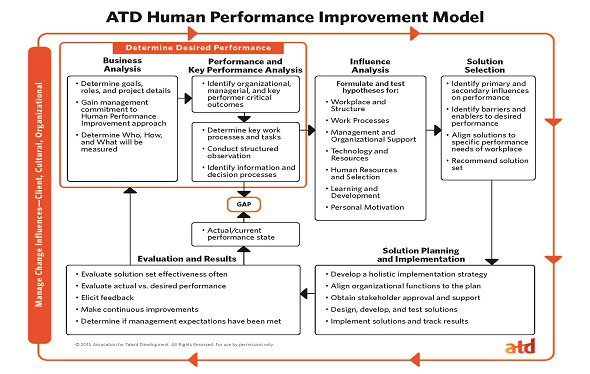I have been pondering on the topic-Performance Improvement. My thoughts have taken shape in this blog and I hope reading it will be worthwhile. Read on…
The prolonged practice of creating conventional training made me feel like I was part of a bucket brigade, passing buckets for someone else to put out the fire-writing my own decline into obsolescence. But, for me conventional training is now passé.
As L&D professionals, we all wish to explore something new, innovative, and challenging. For those reasons, it greatly motivates me to witness this transition from a conventional training mindset to that of a performance improvement mindset.
More often than not, organizations seeking to solve a performance issue resort to Training as a solution without analyzing the nature of the problem. In most cases, training alone does not help to overcome the issue. Here’s where Performance Improvement, also referred to as Human Performance Improvement (HPI), comes into play.
Performance Improvement is not a solution but a methodology for identifying the appropriate solution and setting up systems to ensure “good”, “worthy”, and “desired” performance.
This change in mindset towards corporate learning has been the single-most exciting phase of my career because it is resulting in measurable performance improvements and training that people actually WANT to take.
Quite often the opportunity for Performance Improvement comes in the form of a request for training from the customer. Sometimes, it comes from organizations, inclining towards upskilling the staff. At other times, the need for training may stem within organizations introducing a new role or looking to address a specific performance issue in a specific group/department.
Performance Improvement in a nutshell . . .
Performance Improvement targets a whole range of problems;
-
- Lack of motivation to learn
-
- Inadequate feedback
-
- Poor business processes
-
- Management issues
These are not problems that can be tackled by training alone. Training can be a contributing factor only when the problem is caused by lack of knowledge or skill. To effectively address the problem, we must first consider the organization’s business goal and then analyze the existing performance system-expected to be aligned with the goal. Next, we begin by defining the desired outcome by gathering relevant data, analyzing the gap in the existing system, identifying and implementing a refined performance model and measuring its effectiveness.
Overwhelming! Isn’t it?
Let’s break it down into parts.
How do I gather relevant data?
As learning partners consultants, your goal is to identify the major performance issue by means of ‘relevant data’. This data can be captured by interviewing key decision makers, SMEs and/or representative stakeholders. More often than not, you hit the nail on the head at one meeting and sometimes, though not too often, it takes more than three. Next, you summarize, review, and verify your findings with the key decision makers to get a buy-in/consensus on the desired outcome from the client and other stakeholders.
This data will also help you identify the actual ‘performance state’ of the employees.
How do I define desired performance?
Take note of the desired performance statements agreed-upon during your meetings. Convert those statements into measurable outcomes by attaching to it, a quality, quantity, time, or cost indicator.
Now, our primary goal is in identifying the current state of the “desired performance”, map it against the expected state to identify the gap (gap analysis) and recommend an intervention that would enable the organization in making the best use of its resources and technology to perform at its full potential. Next, you create an evaluation plan to identify the gap between the current and expected state of “desired performance”.
Our solution typically starts to take shape when analyzing this gap. It is on the basis of this evaluation that you identify actual performance and design interventions to overcome these problems.
How do I design interventions?
You must ensure that you have identified the performance gaps BEFORE designing the interventions!
The most critical information that contributes to designing any intervention is identifying the root cause for the “performance gap” (root cause analysis). There are several tools available for root cause analysis-fishbone diagram, Pareto Chart, Scatter Diagram and many more. The result sometimes could be overwhelming, so, be prepared to uncover numerous root causes.
Next, you eliminate the causes that need not be addressed-again, you will need the expertise of your SMEs, stakeholders, and key decision makers. The key here is to map these root causes against the problems/performance factors suggested earlier (lack of motivation, hiring of a wrong person for the job, poor feedback, and so on). Once you have the list of primary causes at your disposal, you are in a better position to decide on the interventions.
The interventions should address the root causes closest to the performance factors.
Next, you design your interventions for each root cause. For example, if there is a need to address the knowledge and skill of the staff then you suggest a training intervention. But, this is not a one-man job, you need a team of specialists, seasoned professionals of the field and of course the key decision makers and stakeholders on the client side. Depending on the expanse of the interventions, you may need to gather more data from your SMEs, stakeholders, or relevant functions/departments of the organization. You may be expected to create a design for each intervention and get the client’s buy-in on it. After which, you implement these interventions and evaluate its results, to conclude if the “desired performance” is met.
Evaluation is not an independent phase or the last phase of the Performance Improvement methodology, it is a repetitive practice. You will be expected to evaluate the effectiveness of each activity/solution/intervention at regular intervals during each lifecycle for Performance Improvement.
There are several Performance Improvement tools and models that can be used to enhance performance. Here are some of the “highly recommended” Performance Improvement Models that can help you design your solution/interventions.
-
- The ATD HPI ModelThe ATD HPI (Human Performance Improvement) model is one of the highly recommended models for successful performance interventions. It is a results-based, systematic process used to identify performance problems; analyze root causes; select, design, and manage performance solutions in the workplace; measure results; and continually improve performance within an organization. Here’s a snapshot:

- The ATD HPI ModelThe ATD HPI (Human Performance Improvement) model is one of the highly recommended models for successful performance interventions. It is a results-based, systematic process used to identify performance problems; analyze root causes; select, design, and manage performance solutions in the workplace; measure results; and continually improve performance within an organization. Here’s a snapshot:
-
- Gilbert’s Behavior Engineering Model (BEM) for Performance AnalysisIn 1978, Thomas Gilbert published Human Competence: Engineering Worthy Performance which described the Behavior Engineering Model (BEM) for performance analysis. Thomas Gilbert is considered as the father of performance technology. His methodology focuses on the variables in the work environment that must be modified or changed to provide performance support. He suggests, “For any given accomplishment, a deficiency in performance always has as its immediate cause a deficiency in a behavior repertory (P), or in the environment that supports the repertory (E), or in both. But its immediate cause will be found in a deficiency of the management system (M).”Aligned with the theory, he proposes the following approach for creating a solution that would help design sustainable performance:
-
- Determining worthy (desired) performance.
-
- Determining the Potential for Improving Performance (PIP).
-
- Diagnosing possible influences on behavior.
According to Gilbert, to design an intervention that can help achieve “worthy” performance, we must identify the influences on behavior. Gilbert states that behavior is the product of the personal characteristics of an individual (repertory) and the environment where behaviors occur. Within each of these aspects of behavior there are conditions that can be examined for deficiencies and ultimately manipulated to improve performance. These six conditions of behavior, numbered according to Gilbert’s suggested sequence for analysis, are outlined in the table below:
-
- Data
-
- Instruments
-
- Incentives
-
- Knowledge
-
- Capacity
-
- Motives
-
- Gilbert’s Behavior Engineering Model (BEM) for Performance AnalysisIn 1978, Thomas Gilbert published Human Competence: Engineering Worthy Performance which described the Behavior Engineering Model (BEM) for performance analysis. Thomas Gilbert is considered as the father of performance technology. His methodology focuses on the variables in the work environment that must be modified or changed to provide performance support. He suggests, “For any given accomplishment, a deficiency in performance always has as its immediate cause a deficiency in a behavior repertory (P), or in the environment that supports the repertory (E), or in both. But its immediate cause will be found in a deficiency of the management system (M).”Aligned with the theory, he proposes the following approach for creating a solution that would help design sustainable performance:
Some tips to help you along the way!
Here are some additional points that you must consider when setting-up systems/processes to ensure performance improvement.
-
- Ensure that everyone is on the same page. When introducing an intervention to overcome or solve a problem, you must ensure that everyone involved is either a witness to the factors causing the problem or is at least aware of its existence.
-
- Align the business goals with the objectives of the performance improvement initiative.
-
- Recognize the fact that these models only help you collect data/facts. It is your responsibility to review and analyze the data to identify the critical problems/root cause(s).
-
- Define specific, measurable and achievable solutions to effectively evaluate the success of the interventions.
-
- Expect that the implementation of these interventions may result in a change that you may not have considered in your solution. Therefore, always consider the consequences of each intervention you suggest.




